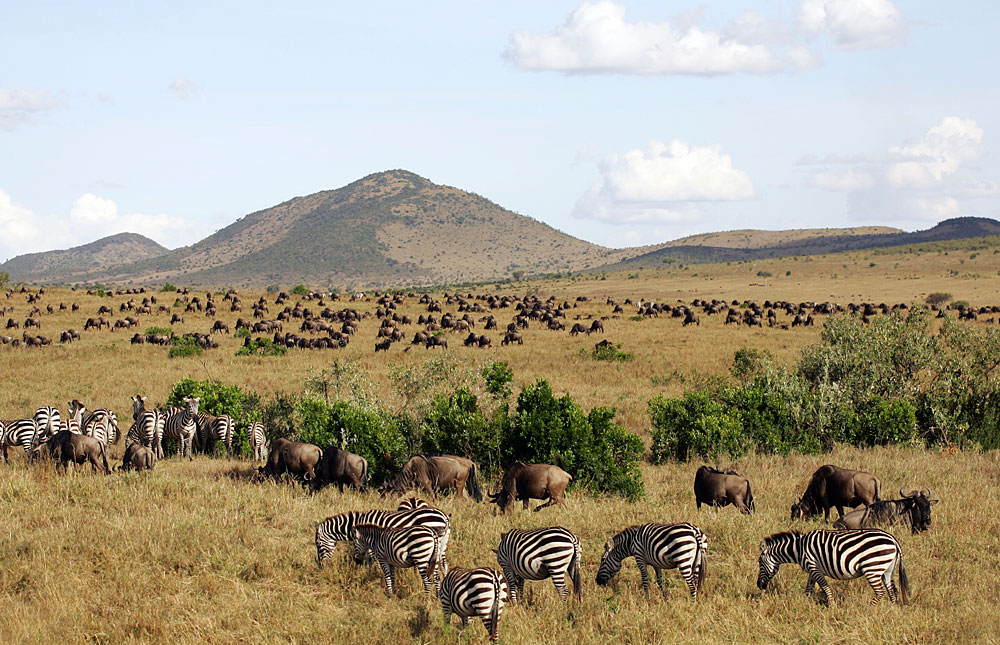Masai Mara Kenya
Maasai Mara national park is a large game reserve in Narok Country Kenya, adjoining with the Serengeti National park in the Mara region in Tanzania. It was named in honour of the Maasai people and their description of the area when looked at from afar. Mara is a word which means Maa in the Masai language for the spotted which is an apt description for the circles of trees, Savannah, scrub and the cloud shadows that mark the area.
The park is also famous for its unique population of the African leopard, Masai lions, Tanzanian cheetahs, and the migration of zebras, wildebeests, thomson’s gazelle to and from Serengeti each and every year from July to October, commonly known as the great migration. The reserve is also a fraction of the greater Mara Ecosystem, which includes the following group ranches: Koiyaki, Lemek, OlChorroOirowua, Olkinyei, Siana, Maji Moto, Naikara, OlDerkesi, Kerinkani, Oloirien, and Kimintet.

Mara Timbo Camp Kenya
Maasai Mara scene with the scattered bushes, animals, cloud shadows and the umbrella acacia trees. The park was established in 196 as a wildlife sanctuary the Mara covered 520 sq km of the current area, including the Mara Triangle. This area also extends to the east in 1961 to cover 1,821km and changed to a game reserve. The Norok country Council took over the management of this reserve at this time. Part of the reserve was given National reserve status in 1974, and the rest of the area was given back to the local communities.
In the year 1994, the transMara country Council was formed in the western part of the reserve, and control was divided between the new council and the existing Norok country council. In 2001, the not for profit Mara Conservancy also took over management of the Mara Triangle. The park covers 1,510km in south western Kenya.
It’s also the northern most region of the Mara-Serengeti ecosystem, which covers some 25000km in Tanzania and Kenya. It is surrounded by the Serengeti Park to the south, the Siria escarpment to the west, and the Maasaipastrol ranches to the north, east, and west. The Talek River and the Mara River are also the major rivers that drain the reserves.
There is large numbers of the migrating wildebeest, there are also the topis, zebras, and the Thomson’s gazelle that migrate into and then occupy the Mara reserve, from the Serengeti plains to the south and Loita plains with in the pastrol ranches to the north east from July to October or later. There are also the elephants, leopards climbing down a tree. All the members of the big five like the leopards, lion, the African elephants, cape buffalo and the black Rhinoceros. The population of the black Rhinos was fairly much until 1960 and it was depleted by poaching in the 1970s and early 1980s, dropping to a low of 15 individuals. The numbers have also been slowly increasing and the population was up to 23 in 1999.
The hippos and the crocodiles are also found in large groups in the Mara and Talex rivers. The hyenas, leopards, cheetahs, jackals, and the bat eared foxes can also be found in the reserve. The plains that are between the Mara River and the EsoitSiria Escarpment are the best area for game viewing in regards to the lions and cheetahs. There are also the wildebeests totalling to 1,300,000, 500, 000 Thomson’s gazelles, 97,000 topis, 18,000 elands, and the 200,000 zebras. These migrants are also followed along their annual, circular route by the predators, mostly the hyenas and the lions. There are also the antelopes, impals, and duikers, Masai Giraffes, over 470 bird species and many more.




